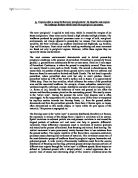The shape, tilt and spin of the earth is the first factor which effects how much energy is absorbed by an area of earth. Due to the proximity of the earth to the sun only one half of the earth will receive daylight at anyone time. This causes day and night and also the time difference across the world. When Australia is facing the sun the British Isles will be in darkness as the sun cannot reach round the earth. It will be daytime in Australia and night time in the UK. The side of the earth facing away from the sun will lose heat because the heat absorbed by the earth will escape with no insolation to replace it. When the earth rotates around again it will be daylight in the UK and night time in Australia.
The tilt of the earth and it's orbit round the sun also make a huge temporal difference to the amount of insolation which reaches a part of the earth. The earth's tilt means that when the North Pole almost directly faces the sun it will have constant daylight, whereas the South Pole will be in complete darkness for almost the entirety of the day. The opposite happens when the earth has orbited so that Antarctica is facing the sun. This happens with other places on the earth but not to the same extremes. For example, when the North Pole is exposed to the sun then it is Summer in the UK. At this time of year the UK will receive sunlight for 2/3rds of the day and 1/3rd of the day will be night time. The opposite happens in Winter and will be happening on the opposite side of the earth in the Southern hemisphere.
Latitude is a factor in spatial and temporal differences in the receipt of insolation. The higher the latitude the higher the sun will be in the sky and so therefore has to travel further to reach the earth. This is due to the curvature of the earth, which also controls how concentrated the sun will be. At the equator the sun travels in a straight line to reach the earth so the 'ray' will be concentrated and more insolation will reach that spot. However the higher the latitude the more the curve of the earth notices, which means the sun has to heat a larger area and therefore one piece of earth will receive less insolation.
Another factor is aspect. This concerns valleys and slopes. If a slope is south facing it will receive more sunlight than a north facing slope. This is due to the direction of the sun's rays. The position of the earth means south facing slopes (ubacs) are in the sun a lot more often than north facing slopes (adrets). Plants will grow more readily on a south facing slope but the north facing slope will be left boggy and sparsely vegetated.
Altitude will affect the efficiency of energy from the sun reaching an area. The ground acts as a radiator as it absorbs energy and converts it into heat. The further you travel from the 'radiator' the colder the air will be, temperature drops 1 degree for every 150m travelled upwards. There is also not enough air density to absorb the sun's energy, meaning no heat is held. This means energy will not convert to heat and will carry on towards the ground. At altitude there is often snow, this reflects the sun's energy and sends it back into space as albedo.
The difference between land and sea, or continentality, is a factor in energy being stored. Whilst land responds to energy very quickly, it does not hold the heat for very long before it is radiated back into the atmosphere. Oceans are translucent so have more insolation spread through them. Due to this the sea will always appear colder than the land because the energy is less concentrated, although it will retain heat for a lot longer than the land. This phenomena means that areas of land by the sea will always be warmer than those inland. The UK has an equable climate due to this. The sea acts as a hot water bottle to keep the edges of the country warm. Winds coming from across the sea carry the warmth inland so the effects appear evident throughout the country.
Finally, the atmosphere itself is a major factor in the storage of energy. The atmosphere acts as a greenhouse to stop energy from escaping into space. This is helped by CO2 emissions which form a 'blanket' which reflects the energy back to the earth enabling it to become heat. Without this 'greenhouse' much of our energy would escape from the earth leaving the earth cold.








